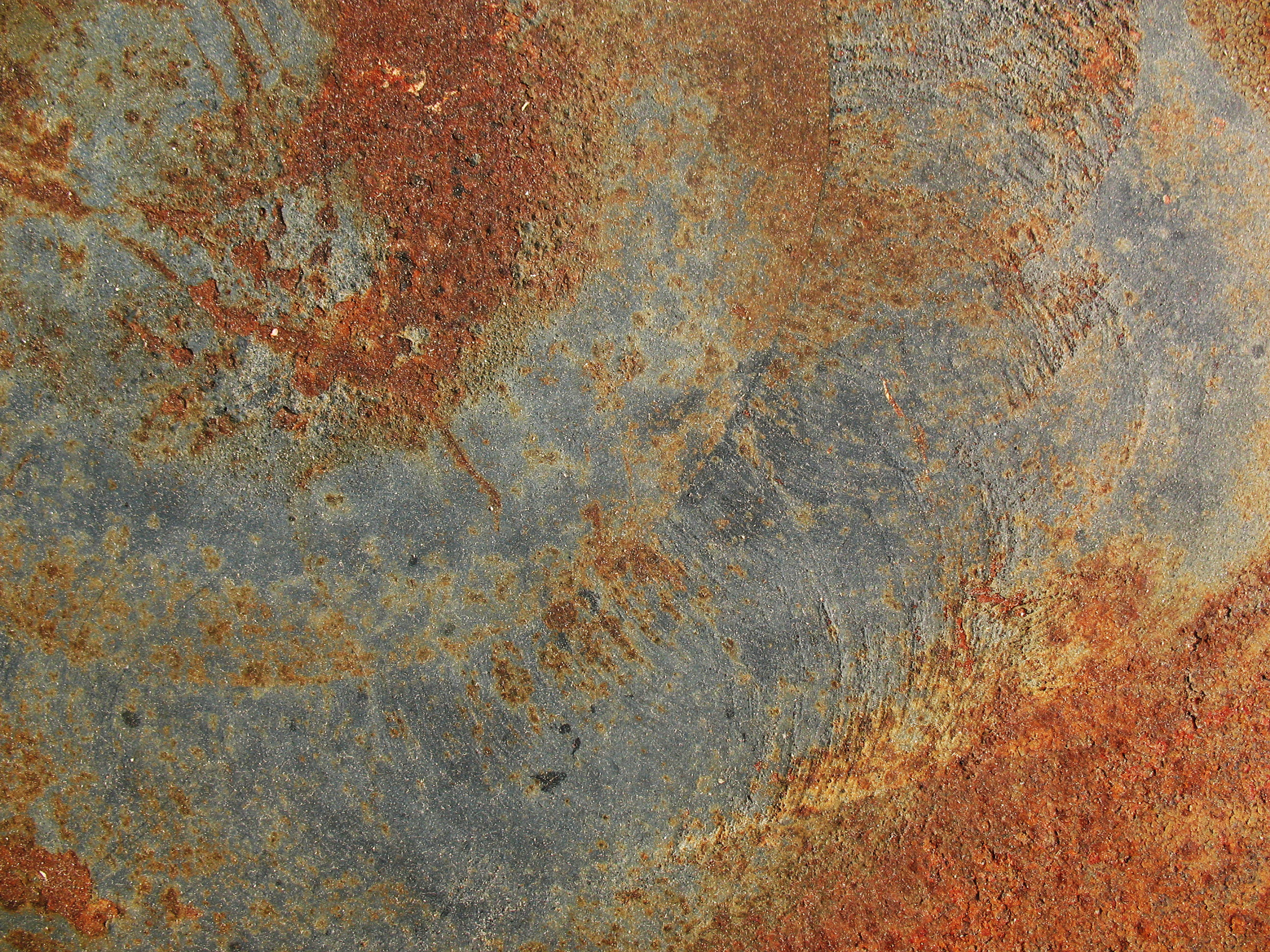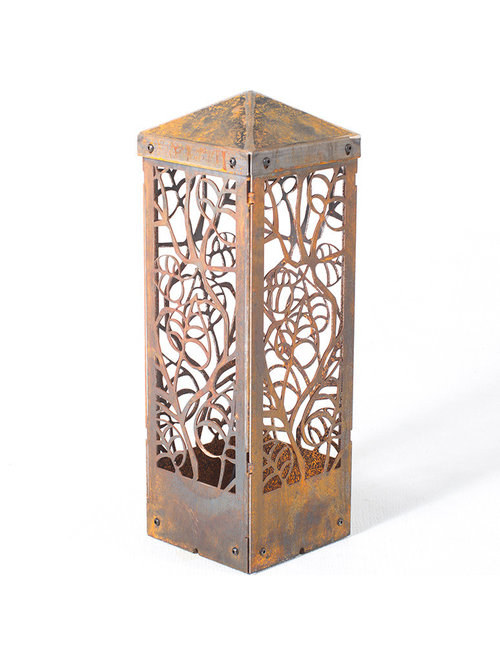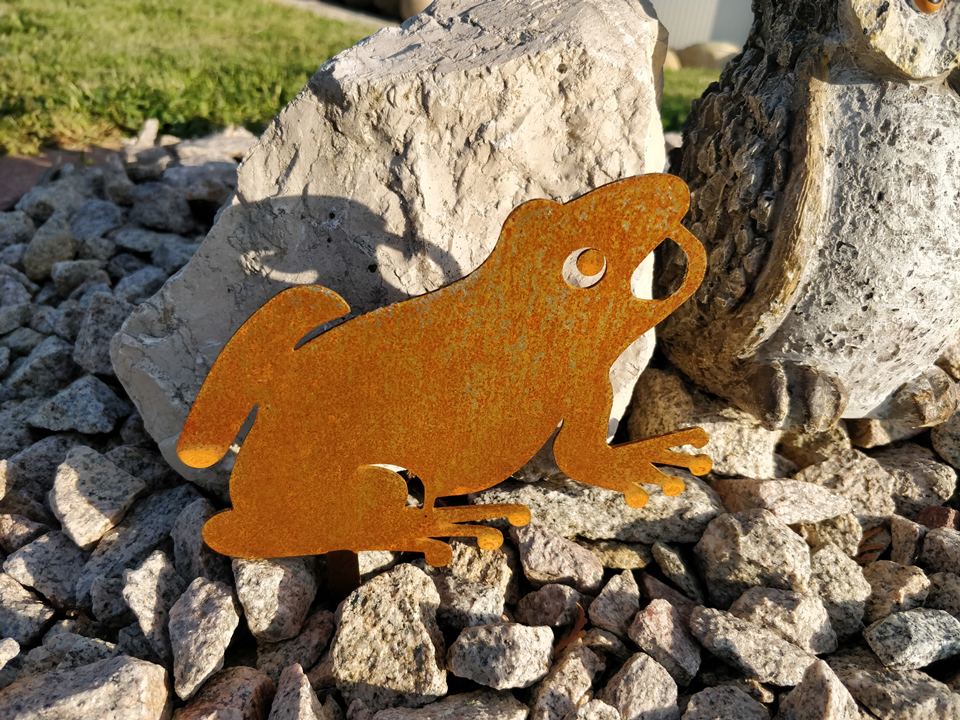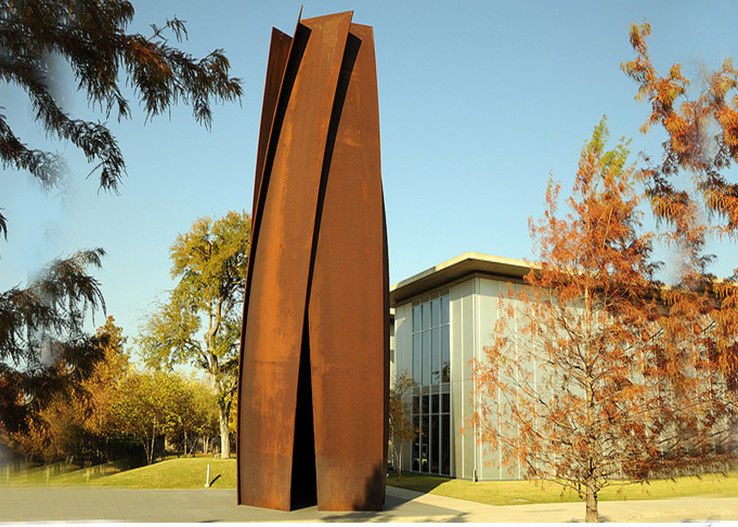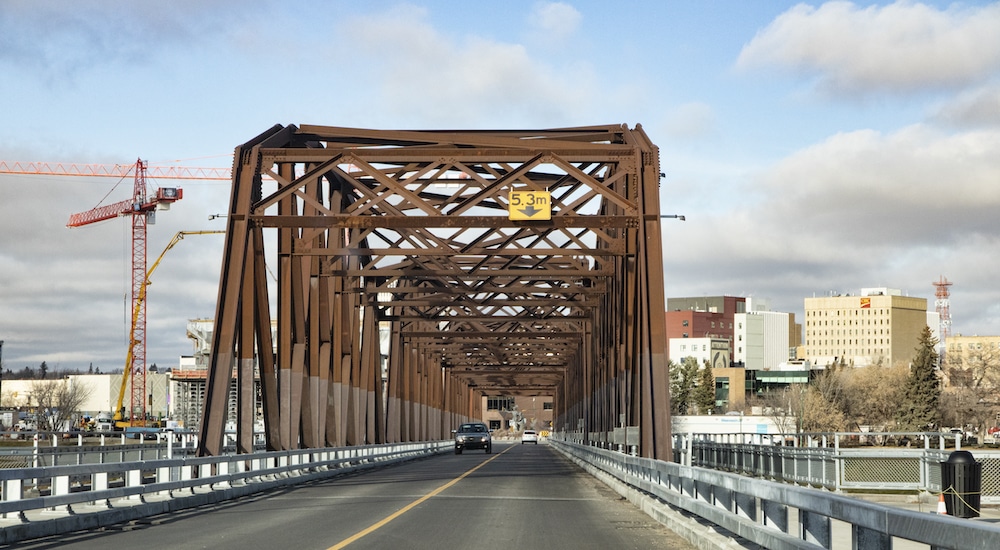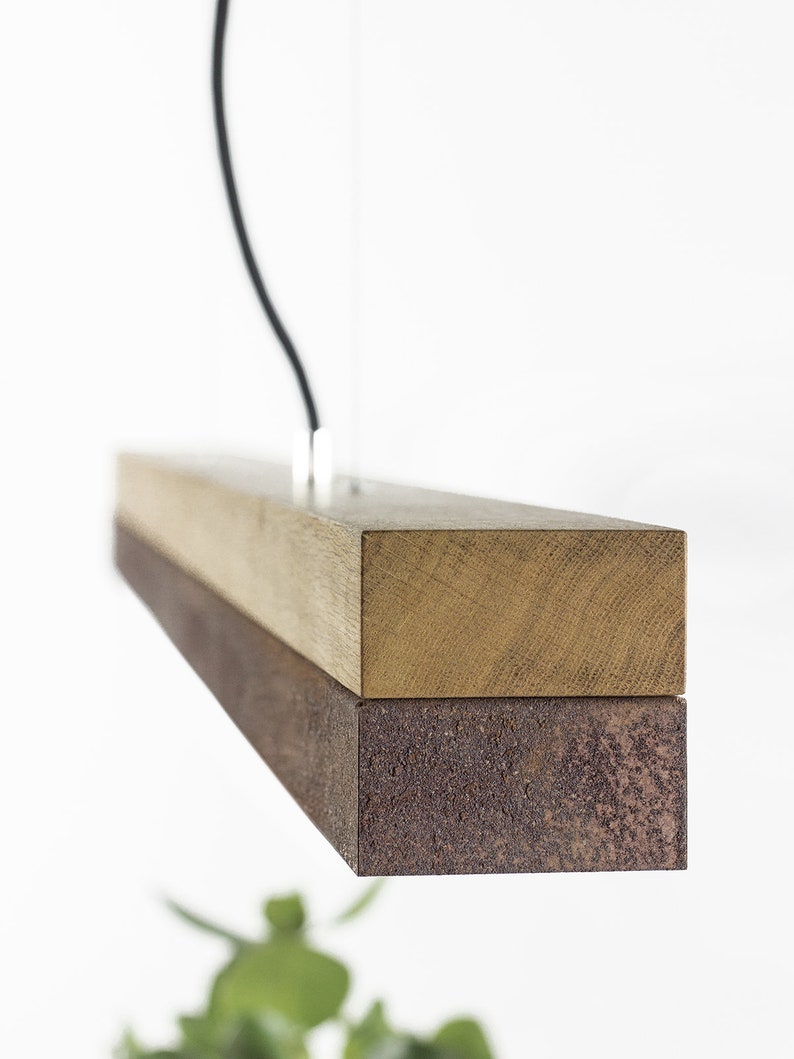Carbon steel is a highly active metal, compared to, for instance, stainless steel and copper. For this reason, any moisture or atmospheric oxygen unpainted carbon steel is exposed to, quickly causes oxidation and formation of ferric hydroxide. As soon as the steel surface moistens multiple times, it becomes rusty, which may considerably worsen the steel structure properties. Cor-ten also oxidizes in the process of contact with air and moisture. However the oxidation mechanism in Cor-ten steel is different from rusting of structural steel. After multiple wetting and drying of Cor-ten steel, a dense and very rigid oxide layer is created on its surface.
This layer prevents from corrosion development in normal weather conditions, therefore Cor-ten is called atmosphere-resistant steel. Weathering steel is not like other corrosion resistant steels, such as austenitic stainless steel, that resist rust formation. Weathering steel will rust, however, it will only rust on the outer surface. The rust does not penetrate deeper into weathering steel once the outer layer of rust has formed.
The surface layer of rust acts as a barrier and actually protects the steel from further corrosion. In plain carbon steel, the rust layer that forms is porous and will break off which allows another layer to form deeper into the steel. This cycle repeats until the steel is rendered useless. In weathering steel, the alloying elements cause the initial rust layer that forms to adhere much better to the steel, preventing the rust from penetrating deeper and weakening the steel. This protective rust layer eliminates the need to coat weathering steel. Rusted metal, including weathered steel and Corten, is a rising trend in architecture and art.
Architects all over the world are embracing rust weathered steel to enhance the patina. Unfortunately, rusted metal can cause stains that drip onto areas under the metal.Corten+ Rust acceleratorGuaranteed result types within the hour on all of types of oxidizing metals . The only acid free rust accelerator therefore without risk of injury to the user. Efficient consumption 800ft² per US Gallon.Corten Steel 101 MetalBuildingHomesCorten steel, sometimes called COR TEN steel, is a weathered steel thats resistant to corrosion. Because of its ability to form a protective layer of rust, corten steel is a popular choice for outdoor sculptures, landscaping, structure exteriors and other outdoor applications. The oxidation process can continue over a period of several years before steady-state 'stabilisation' of the surface occurs with a tightly bonded coating.
This largely depends upon the prevailing atmospheric conditions. ISO indicates that "atmospheres with SO2 pollution allow a more protective rust layer to be formed". COR-TEN has served as weathering steel (atmospheric corrosion- resistant steel). Corten steel plate has successfully overcome rust, steel's most weakest.
When exposed to the atmosphere without painting, corten steel begins to rust in the same way as ordinary steel. BUT soon the alloying elements in COR-TEN cause a protective surface layer of the fine-textured rust to form, thereby suppressing corrosion rate. Since its development in 1993, the COR-TEN has been used in every field where steel applied, such as bridges, railway vehicle and buildings. At present, COR-TEN are attracting attention as being suited for resources and environmental concerns as well as reducing life-cycle costs. The Abetxuko Bridge in Spain – made of Weathering SteelBecause weathering steel can outlast plain carbon steel in outdoor conditions, it is frequently used for exposed steel structures.
This removes the need for constant repainting and recoating of the steel. The corrosion rate of WS is so low that bridges built from weathering steel can easily achieve a 120 year design life with minimal maintenance . No requirement for paint also means no volatile organic compounds are released into the atmosphere and more rapid construction.
The patina on WS not only offers greater corrosion resistance than on mild steel, but is also responsible for its attractive appearance and self‐healing abilities . Steels resistant to atmospheric corrosion, comprise normal structural steels alloyed with copper and phosphorus. Such steel creates a protective oxide layer, which slows the corrosion process in the conditions, when steel can freely become wet and dry in the open air.
Earlier such steel grades were used mainly in industrial structures. However lately their popularity has considerably grown in facade solutions and landscape design, architects consider the Cor-ten colour to be very attractive. Apart from that, Cor-ten steel is a very sustainable material as it requires no additional anti-corrosive treatment. High-strength steels, such as weathering steel, generally exhibit noticeably heavier galvanized coatings than carbon steels. Normally, the thickness of the galvanized coating is appreciably affected by the surface roughness of the steel prior to galvanizing.
Therefore, the increased thickness of galvanized coatings on weathering steel is mainly due to higher levels of silicon that are not found in typical carbon steels. The appearance of the galvanized coating on weathering steel also slightly differs from a typical coating on carbon steel. A matte gray coating with little or no spangle should be expected when galvanizing weathering steel. Often used interchangeably, Corten and weathering steel are essentially the same material and offer high strength and corrosion resistance. Corten steel is ideal for outdoor architectural and landscaping projects. Often used for its aesthetics, Corten steel will exhibit a patina that provides a protective layer from corrosion and atmospheric elements.
Corten steel's appeal includes the ability to use the steel in a range of applications without the need for initial painting and maintenance upkeep. I've had this Maine 'buoy bell' wind chime for about eight years now. It has the haunting melancholy sound of a bell buoy at sea being tossed by wind and waves. It is made of COR-TEN steel which is designed to rust on the surface to create a protective barrier against further rusting. It came painted black on the outside and was supposed to develop this rich rust patina naturally over time.
Seeing it was taking so long, I decided to take things into my own hands and, ah, "help" mother nature along and accelerate the process. I searched the net and found mostly dangerous methods to induce rust on steel using highly caustic or acidic chemical solutions. However I finally did find a simple safe method, using on-hand household chemicals, buried deep within a thread on the subject at a metalworking forum. I got spectacular results which have not only withstood the wind and rain of the southwest but have actually improved with the help of mother nature. Weathering steel is a family of low carbon steels that have additional alloying elements mixed in with the carbon and iron atoms.
These alloying elements give weathering steel better strength and more corrosion resistance than typical low carbon steel grades. As a result, weathering steel is commonly used in outdoor applications or environments where normal steel would be inclined to rust. A. Abrasive blasting is the way to go for an even rust finish. I have found that the original rusting stage does produce staining but once this has been achieved the run off is minimal. Inital surface weathering of bare weathering steel typically leads to heavy rust staining on nearby surfaces, especially concrete. This could easily be solved by getting rid of designs which would drain the loose rust products on to nearby surfaces.
Use a weathering steel,also known as "COR-TEN" steel which contains up to 21% of alloying elements such as chromium, copper, nickel, and phosphorous. The alloys form a protective rust patina which reduces the corrosion rate with time. COR-TEN steel tends to be cheaper than stainless steel. In 1930's America, coal wagon manufacturers noticed certain steel alloys developed a layer of rust that instead of corroding the steel when exposed to the elements, protected it.
The alloys continued to undergo development to improve their strength and durability. In time, the name lost its hyphen and become a generic term. Corten steel is also known and weathering-steel or weathered steel.
There is a difference between simply just letting steel rust in your backyard and real corten steel. Steel garden ornaments are often made with a thin gauge mild steel because it's easy to cut and can therefore have more fine detailing. Simply put, that steel isn't designed for lasting outside in the elements and as it begins to rust, it can rust away quite quickly. The question you can ask when buying such ornaments is whether it's made of weathering steel and if it's not, then look at the thickness of the actual steel used. 3-5mm mild steel will also last a fairly long time in any garden, irrespective of the conditions. With weathering steel, the rusting process happens in the same way, but the steel produces a stable rust layer, called a "patina," which serves as a protective, corrosion-resistant barrier.
This naturally-developed protective patina regenerates continuously when exposed to weather and stops further access of oxygen, moisture and pollutants. You can seal rusted metal to prevent further corrosion and sealing will also prevent rust stains from getting on other surfaces around it or your hands. Corten steel can be sealed with polyurethane or a product called Everbrite, for a more durable finish .
The fast and DIY way to rust metal on purpose is to make a mixture in a spray bottle of white vinegar, hydrogen peroxide, and salt. Spray the mixture onto the metal surface several times, letting it dry between coats and your metal will take on a rusty patina almost instantly. Weathering steel , also known as low‐alloy steel, are steels with a carbon content of less than 0.2 wt.
% to which mainly Cu, Cr, Ni, P, Si and Mn are added as alloying elements to a total of no more than 3‐5 wt. It occurs when iron combines with the oxygen in the air causing it to corrode. Rust is the orange-brown discoloration that builds up on metal. Rust can affect iron and its alloys, including steel. Whenever you have iron, water and oxygen together, you get rust.
Although iron and steel structures seem solid to the eye, water molecules are able to penetrate microscopic gaps in the metal. If salt is present, for example in seawater, the corrosion will be more rapid. Exposure to sulfur dioxide and carbon dioxide will also hasten the corrosive process. The most practical benefit of weathering steel is its ability to resist corrosion. When exposed to moisture, air, and other elements, most low alloy steels have the tendency to rust. And overtime, the rust layer becomes porous and detaches from the metal surface.
Depending on application, Cor-ten steel can be used as it is or be painted. In case of correct usage, unprocessed Cor-ten steel quickly forms a dense and rigid oxide layer, which prevents from rust progressing. Corten steel fire pit beginning to patinaThe alloys in weathering steel allow rust or surface oxidation to occur naturally over the course of about six months under normal exterior conditions. Use of chemical treatments can help speed up the process and produce the patina in as little as two hours. As the steel surface "rusts" it creates a regenerating corrosion-retarding layer that protects the main structure of the steel. Although Corten steel is corrosion resistant, it is not completely rust-proof.
Most weathering steel types need cycles of wet/dry weather to develop and oxidize. Cor-ten steel may be painted with any paint designed for steel anti-corrosion treatment. Research has shown that the durability of alkyd paint coating on Cor-ten steel is 1.5-2 times more than that of carbon steel. The figure below shows the external appearance of painted Cor-ten and carbon steel samples after test use within 15 years in marine climate.
In the right part of the figure, painted samples exposed to industrial environment within several years, are shown. Cor-ten steel does not show features of rust under the paint coat consisting of zinc-chromate primer and vinyl paint. A high-strength, low-alloy steel plate utilized primarily in structural applications such as bridges and buildings. This grade is designed for projects requiring atmospheric corrosion resistance. Corten steel is a mixture of steel and alloys that varies according to the grade of corten steel. Before exposure to the elements its dull, dark grey surface might suggest the wrong product has been supplied, but over time it will develop a patina that is unique to each piece.
Corten steel is a weathering metal that will naturally form an orange and brownish rust-like protective coating. Corten steel planter boxes easily add to the modern or rustic look of your home or business. Rusting effects may stain and damage the surface it's placed on like concrete or stone. This unique type of metal undergoes a natural rusting process when exposed outdoors.
It starts out unrusted and over a period of time you'll see a difference in the texture and colors. The colors will range from brown, dark orange, or a combination of both colors. Under more extreme temperature conditions, Corten steel will rust faster creating more drastic changes in it's appearance.
Unlike other planter box materials, Corten steel is a weathering steel which means that over-time it will naturally form a beautiful rust-like protective coating. Corten steel is a good choice because it has a longer lifespan than normal steel and develops a beautiful rustic finish. When metal parts are properly stored with VCI Packaging products, VCIs activate and fill up the vapor space inside the packaging. The VCI ions form a shield of protection on the surface of metal that displaces moisture and eradicates rust.
VCI Packaging safely prevents corrosion on protected metals without the need for messy grease, oils, protective coatings or other time-consuming methods. The alloys in weathering steel allow rust or surface oxidation to occur naturally over the course of about six months under normal exterior conditions. Steel garden ornaments are often made with a thin gauge mild steel because it's easy to cut and can therefore have more intricate detailing. Simply put, that steel isn't designed for existing outside in the elements and as it begins to rust, it can rust away quite quickly.
The process of coating a thicker metal base with zinc shields the material from the elements and prevents corrosion. The steel is protected from rust and erosion that can be caused when the object is exposed to rain, high or low temperatures in the climate and some chemicals that some into contact with it. In simple terms the process of galvanising steel elongates it's life and ensure the metal will be of the highest quality as possible, for as long as possible. Galvanising steel means that the material will remain reliable and strong. Using galvanised steel is also a cost effective alternative to using materials such as aluminium or stainless steel. So, you've prepped the metal object for rusting, but how does the oxidation process happen?
First, you'll need to create a rusting solution by combining 16oz hydrogen peroxide, 2oz white vinegar, and ½ tablespoon of salt. If possible, mix this solution in the spray bottle with some leftover white vinegar. Shake it up so that everything mixes well, and then start spraying down your object. If the rusting doesn't start happening immediately, you may need to put your object in direct sunlight for a while.
Yes, the next step is just like pickling cucumbers, only here you're pickling steel. Steel pickling helps create a uniform coat of rust instead of specific areas being rustier than others. Pour some white vinegar into the spray bottle and then spray every inch of the metal object. Let it dry in the sun, and then repeat several more times. Now, your steel will be ready for the metal rusting process. Pour two cups of hydrogen peroxide, four tablespoons of white vinegar, and one-and-a-half teaspoons of table salt into a plastic spray bottle.


